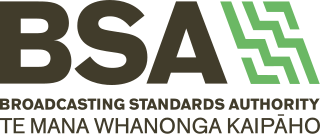Related Research Articles

Television New Zealand, more commonly referred to as TVNZ, is a television network that is broadcast throughout New Zealand and parts of the Pacific region. All of its currently-operating channels are free-to-air and commercially funded.

Spark New Zealand Limited is a New Zealand telecommunications and digital services company providing fixed-line telephone services, mobile phone services, broadband, and digital technology services. Its customers range from consumers to small - medium business, government agencies and large enterprise clients. It was formerly known as Telecom New Zealand until it was rebranded to Spark on 8 August 2014. It has operated as a publicly traded company since 1990. Spark's mobile network reaches 98% of New Zealand, with over 2.7 million mobile connections and 687,000 broadband connections

Shortland Street is a New Zealand prime-time soap opera centring on the fictitious Shortland Street Hospital. The show was first broadcast on TVNZ 2 on 25 May 1992 and is New Zealand's longest-running drama and soap opera, being broadcast continuously for over 8,000 episodes and 32 years. It is one of the most watched television programmes in New Zealand.
Three, stylised as +HR=E, is a New Zealand nationwide television channel. Launched on 26 November 1989 as TV3, it was New Zealand's first privately owned television channel. The channel currently broadcasts nationally in digital free-to-air form via the state-owned Kordia on terrestrial and satellite. Vodafone also carries the channel for their cable subscribers in Wellington and Christchurch. It previously broadcast nationally on analogue television until that was switched off on 1 December 2013.

Newstalk ZB is a nationwide New Zealand talk-radio network operated by NZME Radio. It is available in almost every radio market area in New Zealand, and has news reporters based in many of them. In addition to talkback, the network also broadcasts news, interviews, music, and sports. The network's hosts include Kate Hawkesby, Mike Hosking, Kerre Woodham, Simon Barnett, James Daniels, Heather du Plessis-Allan, Marcus Lush, Andrew Dickens, Jack Tame and Francesca Rudkin. Wellington and Christchurch have a local morning show.

Ngāi Tūhoe, often known simply as Tūhoe, is a Māori iwi of New Zealand. It takes its name from an ancestral figure, Tūhoe-pōtiki. Tūhoe is a Māori-language word meaning 'steep' or 'high noon'. Tūhoe people also bear the sobriquet Nga Tamariki o te Kohu. Tūhoe traditional land is at Te Urewera in the eastern North Island, a steep, heavily forested area which includes Lake Waikaremoana. Tūhoe traditionally relied on the forest for their needs. The tribe had its main centres of population in the small mountain valleys of Ahikereru and Ruatāhuna, with Maungapohatu, the inner sanctum of the Urewera, as their sacred mountain. The Tūhoe country had a great reputation among the neighbouring tribes as a graveyard for invading forces.

Hone Pani Tamati Waka Nene Harawira is a New Zealand Māori activist and former parliamentarian. He was elected to parliament as the member for the Māori electorate of Te Tai Tokerau in 2005 as the Māori Party candidate.

John James Campbell is a New Zealand journalist and radio and television personality. He is currently a presenter and reporter at TVNZ; before that, he presented Checkpoint, Radio New Zealand's drive time show, from 2016 to 2018. For ten years prior to that, he presented Campbell Live, a 7 p.m. current affairs programme on TV3. He was a rugby commentator for Sky Sports during the All Blacks' test against Samoa in early 2015 — a fixture he had vocally campaigned for while hosting Campbell Live.

Paul Henry Hopes, known professionally as Paul Henry, is a New Zealand radio and television broadcaster who was the host of the late night show The Paul Henry Show on New Zealand's TV3 which ended December 2014 so that Henry could host a new cross-platform three-hour breakfast show Monday to Friday on TV3, RadioLive and online. Paul Henry launched on 7 April 2015 and initially had an audience larger than the two shows it replaced on radio and TV. For nine months in 2012, he also co-hosted an Australian television show, Breakfast, which ceased production on 30 November 2012, due to low ratings. Henry is host of The Traitors NZ series 1 & 2. He won Bronze as Best Host for series 1 at the New York Festivals in April 2024. Series 2 is set to air June 2024.

60 Minutes is a New Zealand newsmagazine television show. It was originally broadcast on TV3. The show began in New Zealand in 1989 based on the American programme by the same name.

The Broadcasting Standards Authority is a New Zealand Crown entity created by the Broadcasting Act 1989 to develop and uphold standards of broadcasting for radio, free-to-air and pay television.

TVNZ 7 was a commercial-free New Zealand 24-hour news and information channel on Freeview digital television platform and on Sky Television from 1 July 2009. It was produced by Television New Zealand, which received Government funding to launch two additional channels. The channel went to air just after 10 am on 25 March 2008 with a looped preview reel. The channel was officially launched at noon on 30 March 2008 with a special "kingmaker" political debate held within the Parliament building and featuring most of the elected minor party leaders. The channel went off air at midnight on 30 June 2012 to the Goodnight Kiwi.

Oliver Sean Plunket is a New Zealand broadcast journalist. Plunket has worked for several New Zealand broadcast media companies and stations including Radio Windy, Independent Radio News, Radio New Zealand, TV3, TVNZ, Newstalk ZB, and MagicTalk. Plunket also served as the communications director of The Opportunities Party during the 2017 New Zealand general election. In late 2021, Plunket founded an online radio station The Platform.
Michael Noel James Hosking IV is a New Zealand television and radio broadcaster who has worked for Radio New Zealand and TVNZ and from 2008 has been the weekday breakfast host on Newstalk ZB with "The Mike Hosking Breakfast". He is a supporter of the centre-right National party and is often openly critical of the Labour-led government. He has lived and worked as a broadcaster in Wellington, Christchurch and currently resides in Auckland.

The Office of the Children's Commissioner was an independent New Zealand Crown entity that was established under the Children's Commissioner Act 2003. Its role has been superseded by Mana Mokopuna - Children and Young People's Commission. OCC's main responsibilities were to protect the rights, health, welfare, and wellbeing of minors under the age of 18 years.
New Zealand is committed to the Universal Declaration of Human Rights and has ratified the International Covenant on Civil and Political Rights, both of which contain a right to privacy. Privacy law in New Zealand is dealt with by statute and the common law. The Privacy Act 2020 addresses the collection, storage and handling of information. A general right to privacy has otherwise been created in the tort of privacy. Such a right was recognised in Hosking v Runting [2003] 3 NZLR 385, a case that dealt with publication of private facts. In the subsequent case C v Holland [2012] NZHC 2155 the Court recognised a right to privacy in the sense of seclusion or a right to be free from unwanted intrusion.

Dame Alcyion Cynthia Kiro is a New Zealand public-health academic, administrator, and advocate, who has been serving as the 22nd governor-general of New Zealand since 21 October 2021. Kiro is the first Māori woman and the third person of Māori descent to hold the office.

Apna is a New Zealand radio network targeted towards ethnic minorities. The radio network broadcasts on 990 AM in Whangārei, Auckland and Hamilton, and plays Bollywood music alongside cultural features and discussions.

Radio Tarana is a New Zealand radio network, broadcasting in Auckland. It broadcasts a mixture of music, information, news, sports, culture, events coverage and lifestyle features. The station was the first commercial full-time New Zealand radio station targeting migrant communities. According to the 2014 TNS New Zealand radio survey, it remains the highest-rating ethnic broadcaster in the country.

Parikino is a settlement 24 kilometres (15 mi) upriver from Whanganui, New Zealand; the original pā site was across the Whanganui River.
References
- ↑ Binning, Elizabeth (May 12, 2007). "From happiness to hell". The New Zealand Herald . Archived from the original on 2012-01-02. Retrieved 5 October 2012.
- ↑ Vass, Beck (15 June 2007). "Ex-carer tells boy's killers to hang themselves". The New Zealand Herald . Archived from the original on 2015-09-24. Retrieved 8 October 2011.
- ↑ Vass, Beck (16 June 2007). "Toddler's killers get 8 1/2 years". The New Zealand Herald . Retrieved 8 October 2011.
- 1 2 Carroll, Joanne (11 December 2011). "Child killer gives birth in jail". The New Zealand Herald . Archived from the original on 2011-12-10. Retrieved 11 December 2011.
'She has a lot of children and we believe she has even given birth to another child while on this prison sentence. That child has been fostered or adopted into the community,' the report said.
- ↑ "Teusila Ki Vaiola Fa'asisila". Offender Database. Sensible Sentencing Trust. Archived from the original on 13 October 2012. Retrieved 6 October 2012.
- 1 2 3 4 5 6 7 8 9 "Kiro and Television New Zealand Ltd - 2007-111; Complaint under section 8(1)(a) of the Broadcasting Act 1989". bsa.govt.nz. Broadcasting Standards Authority. 26 March 2008. Archived from the original on 15 April 2012. Retrieved 5 October 2012.
- 1 2 "Call to stand up against abuse". TV One (New Zealand). 6 August 2007. Archived from the original on 2018-03-16. Retrieved 16 October 2012.
- 1 2 3 "Complaint about autopsy photos rejected". The Dominion Post . 1 April 2008. Retrieved 16 October 2012.
- 1 2 "E-mailer backs abuse photos". stuff.co.nz. Dominion Post. 6 August 2007. Retrieved 8 October 2011.
- ↑ "The real face of child abuse in NZ". biggie.co.nz. 31 July 2007. Archived from the original on 25 February 2012. Retrieved 9 October 2011.
- 1 2 "Photos sent in emails of dead boy slammed". stuff.co.nz . 5 August 2007. Retrieved 8 October 2011.
- ↑ "Grisly photos in email petition". stuff.co.nz. 6 August 2007. Retrieved 8 October 2011.
- ↑ "Sentence for Beating Partner to Death slammed". Press Release. Family First / Scoop (website). 28 February 2008. Archived from the original on 2016-03-04. Retrieved 8 October 2011.
His entire body was covered in bruises and his blood was found in every inch of the house. Yet his mother and step-father will be up for parole in four years.
- ↑ "Child Abusers Are Also Women". Press Release. Family First / Scoop. 31 July 2007. Archived from the original on 2015-09-26. Retrieved 8 October 2011.
- ↑ "Ngatikaura Ngati". flickr.com. 2011. Retrieved 8 October 2011.
- ↑ "Dead child's pictures posted on pornographic website". Otago Daily Times. 7 October 2011. Archived from the original on 2011-10-09. Retrieved 10 October 2012.
- ↑ "Disgust over dead boy's pictures on porn site". New Zealand Herald. 8 October 2011. Archived from the original on 2011-11-04. Retrieved 8 October 2011.
Ngatikaura Ngati died after horrific abuse by his parents. Children's advocates are appalled that pictures of a young Auckland boy killed by his parents were posted on a pornographic site featuring beheadings, impalement and necrophilia.